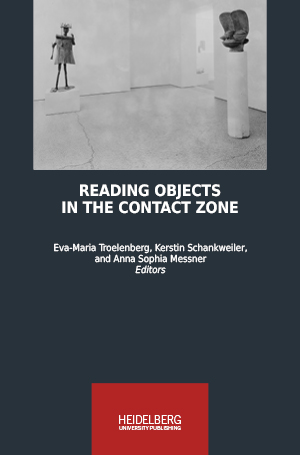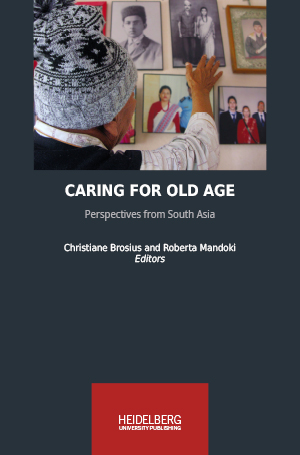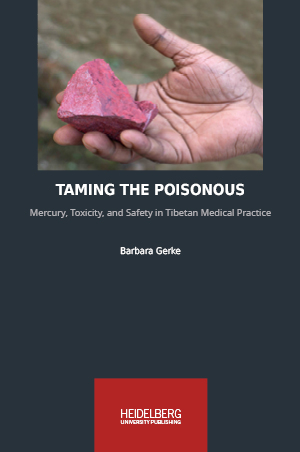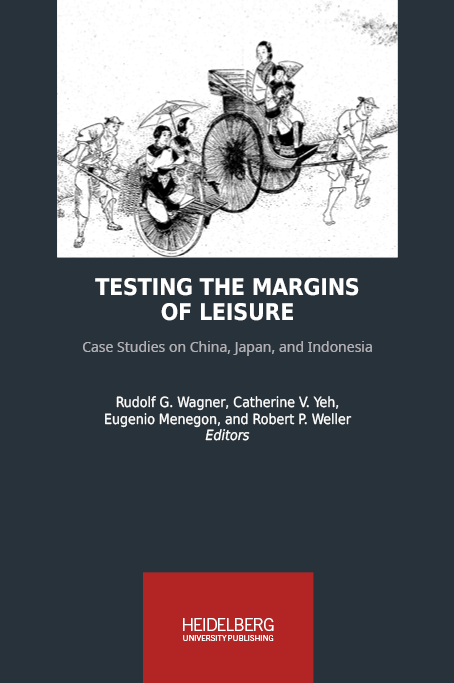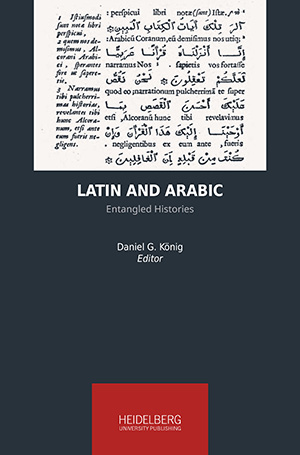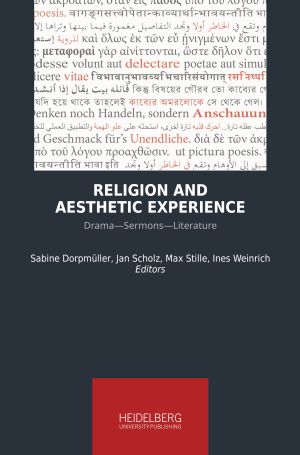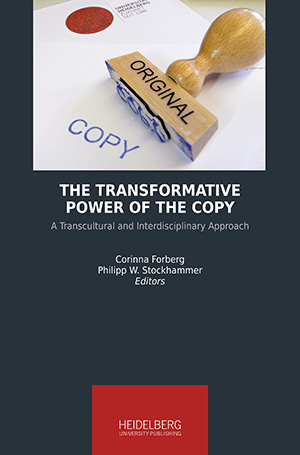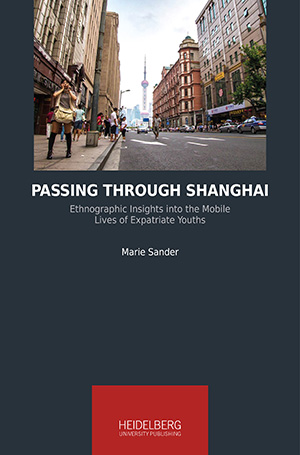Heidelberg Studies on Transculturality
Heidelberg Studies on Transculturality hat sich die Veröffentlichung von Forschung zum Ziel gesetzt, die die Dynamik transkultureller Beziehungen in jeder Region der Welt untersuchen. Die Reihe umfasst Werke, die sowohl innerhalb von Einzeldisziplinen als auch zwischen ihnen positioniert sind. Einreichungen sind insbesondere aus den folgenden Bereichen willkommen: Anthropologie, Kunstgeschichte, Kultur- und Religionswissenschaft, Politik, Literaturwissenschaft, Medien und Kommunikation, Musikwissenschaft, Gesundheitswesen.
Transkulturelle Forschung basiert oft auf der Auseinandersetzung mit verschiedenen Medien (Bild, Ton, Video etc.), die idealerweise auch in die Publikation eingebunden sein sollten. Da unsere elektronischen Endformate dies unterstützen, eignen sich die digitalen Publikationsformate der Reihe sehr gut für Arbeiten aus der transkulturellen Forschung und entsprechen dem Bedürfnis der auf diesem Gebiet tätigen Forscher, neue, flexible, zeitgemäße und frei zugängliche Technologien zu nutzen, die ihre Publikationen einem globalen Publikum zugänglich machen.
Heidelberg Studies on Transculturality
Herausgeber
Reuven Amitai, Jerusalem
Christiane Brosius, Heidelberg
Beatrix Busse, Köln
Prasenjit Duara, Durham
Christian Henriot, Lyon
Madeleine Herren, Basel
Nikolas Jaspert, Heidelberg
Monica Juneja, Heidelberg
Joachim Kurtz, Heidelberg
Thomas Maissen, Paris
Joseph Maran, Heidelberg
Axel Michaels, Heidelberg
Barbara Mittler, Heidelberg
Sumathi Ramaswamy, Durham
Rudolf Wagner (†), Heidelberg
Roland Wenzlhuemer, München
Heidelberg Centre for Transcultural Studies (HCTS)
Hinweise für Autoren
Kontakt
Bisher erschienen
Being Single in the City: Cultural Geographies of Gendered Urban Space in Asia
Was bedeutet es, eine alleinstehende Frau in Indien oder China zu sein? Singles sind auf dem Vormarsch, auch in Asien. Es gibt eine ambivalente Faszination für die alleinstehende Frau als neuen Typus der selbstbewussten, kompetenten „Lifestyle-Surferin“ und engagierten Karrieremacherin. Und doch wird die alleinstehende Frau auch stigmatisiert, diskriminiert oder als jemand stereotypisiert, der soziale Normen herausfordert. Orte sind wichtig für das Singledasein: dieses Buch konzentriert sich insbesondere auf urbane Räume Indiens, des chinesischen Festlandes und Hongkongs. Schließlich manifestieren sich hier soziale, wirtschaftliche, kulturelle und politische Transformationen, werden neue Lebensmöglichkeiten erprobt und lebhaft diskutiert.
Collectives, Localities, Networks: A Translocal Ethnography of Emerging Contemporary Art Field(s) in Nepal and Bangladesh
Künstler*innenkollektive entwickeln sich zu einer treibenden Kraft im Kunstfeld. Sie aktivieren neue Räume für künstlerische Praxis und Präsentation. Sie gestalten neu aufkommende Formate, von Kunstprojekten in der Nachbarschaft bis hin zu großangelegten Biennalen. In ihrer Praxis hinterfragen die Kunstschaffenden etablierte Kunstbegriffe sowie hegemoniale Umschreibungen von Lokalität.
Dieses Buch ist das Ergebnis einer langjährigen Arbeit mit zeitgenössischen Kunstschaffenden in Nepal und Bangladesch. Es verfolgt einen akteurszentrierten Ansatz, um die Begriffe contemporaneity und collectivity zu entschlüsseln. Sein Fokus auf kollaborative Kunstpraktiken in Verbindung mit einer multiskalaren und translokalen Perspektive fordert uns dazu auf, die Verwendung von häufig Hierarchien transportierenden Begriffen wie Stadt, Region oder Globalität zu überdenken.
Reading Objects in the Contact Zone
Die kulturellen Auswirkungen der Globalisierung gehören heute zu den bedeutendsten Herausforderungen für das Fach Kunstgeschichte. Ziel dieser Publikation ist eine kritische Betrachtung kunsthistorischer Narrative auf der Basis von transkulturellen Objekt-Biografien. Der Band versammelt Analysen von Objekten und Bildern, deren Entstehungs- und Rezeptionsgeschichten sich über Kulturräume und Epochen hinwegbewegen. Sie führen beispielhaft vor, wie Wissen und Erkenntnis in kulturellen Kontaktzonen erzeugt, transportiert oder auch herausgefordert werden. Auf diese Weise versteht sich die Publikation als methodischer Beitrag zu einer transkulturellen Kunst- und Kulturgeschichte. Sie ist auch für den Einsatz in der universitären Lehre konzipiert und beinhaltet ein kritisch-diskursives Glossar von Schlüsselbegriffen, die Theorie und Praxis der transkulturellen Kunstgeschichte miteinander verbinden.
Caring for Old Age: Perspectives from South Asia
Neben zunehmender Urbanisierung und Mobilität erleben viele Gesellschaften gleichzeitig steigende Lebenserwartungen und ein Älterwerden ihrer Gesamtbevölkerung. Solch grundlegende demografische und strukturelle Veränderungen spiegeln sich in einer Vielzahl von Narrativen und Strategien wider, wie ein „gutes Alter(n)“ angesichts sich rapide transformierender Umgebungen, der Mobilität von Menschen und sich wandelnder sozialer Beziehungen aussehen kann. Dieser Band erforscht die transkulturellen Dimensionen von Alter(n) und Care in ethnografischen und literarischen Fallstudien sowohl in Südasien als auch in einer südasiatischen Studie in Europa. Die elf Beiträge dieses Bandes setzen sich kritisch mit eurozentrischen Aspekten in der Alter(n)sforschung auseinander und untersuchen, wie Perspektiven aus dem Globalen Süden transkulturelle Verflechtungen und Konnektivitäten von Care- und Alter(n)serfahrungen aufzeigen können.
Taming the Poisonous: Mercury, Toxicity, and Safety in Tibetan Medical Practice
Diese umfassende ethnografische und sozio-historische Forschungsarbeit zeigt, wie verschiedene Sichtweisen von Toxizität und Sicherheit in einer globalisierenden Welt transkulturell zum Ausdruck kommen. Das Buch untersucht erstmalig den „pharmaceutical nexus“ von Quecksilber in der tibetischen Medizin (Sowa Rigpa). Dort wird es seit dem 13. Jahrhundert hauptsächlich in Form von tsotel, einer metallorganischen Quecksilbersulfidverbindung verwendet, welches in kleinen Mengen bestimmten Arzneimitteln zugesetzt wird, um die Wirksamkeit anderer Inhaltsstoffe zu verbessern. In Übereinstimmung mit tantrisch-buddhistischen Ideen setzen sich tibetische Ärzte mit giftigen Substanzen auseinander und verwandeln sie durch „Zähmung“ in wirksame Medikamente und Elixiere, anstatt sie zu vermeiden oder auszuleiten.
Seit kurzem löst das vom Umweltprogramm der Vereinten Nationen initiierte weltweite Minamata-Übereinkommen Debatten über die Verwendung von Quecksilber in asiatischen Arzneimitteln aus. In diesem Zusammenhang interagieren asiatische Medizintraditionen zunehmend mit biomedizinischer Wissenschaft und Technologie. Dabei stellt sich die Frage, was auf dem Spiel steht, wenn tibetische Ärzte in Indien und Nepal, Forscher und Aufsichtsbehörden die Toxizität und Sicherheit von Quecksilber unterschiedlich definieren. Wer bestimmt, was „giftig“ und was „sicher“ ist, und wie? Was bedeutet dies für die Zukunft der traditionellen asiatischen medizinischen und pharmazeutischen Praxis?
Testing the Margins of Leisure: Case Studies on China, Japan, and Indonesia
Dieser Band vereint acht Studien zu verschiedenen historischen und aktuellen Aspekten von Freizeit in Asien. Er setzt sich kritisch mit dem vorherrschenden eurozentrischen Schwerpunkt der Freizeitforschung auseinander und bringt eine Reihe von zentralen Fragen wie etwa die Rolle der Freizeit als transkultureller Kontaktzone in die Diskussion mit ein. Der Band beschäftigt sich mit einem Gebiet, das aufgrund der verstärkten Bedeutung von Freizeitaktivitäten für die Definition der Identität einer Person, der sich verwischenden Grenzen zwischen Arbeit und Freizeit im postindustriellen Zeitalter und der zunehmenden wirtschaftlichen Bedeutung von Freizeitaktivitäten wie dem Tourismus rasch wächst. Die Einbeziehung Asiens in die Diskussion trägt dazu bei, das Freizeitforschung in einen globalen Kontext zu stellen.
Latin and Arabic: Entangled Histories
Latein und Arabisch haben als Sprachsysteme mit einer großen Vielfalt an schriftlichen und mündlichen Registern, darunter “Sprachen” und Dialekte”, in der Geschichte des Euromediterraneums seit der Antike eine herausragende Rolle gespielt. Aufgrund ihrer lang anhaltenden Funktion als Sprachen der Administration, intellektueller Aktivität und Religion, werden sie oft als kultureller Marker Europas und der arabisch-islamischen Sphäre betrachtet. Dieser Band untersucht die vielen Facetten lateinisch-arabischer Verflechtung aus makro- und mikrohistorischer Perspektive. Er stellt die binäre Opposition von “Islam” und “dem Westen” in Frage und hebt die sprachliche Dimension christlich-muslimischer Beziehungen hervor.
Religion and Aesthetic Experience: Drama—Sermons—Literature
Die Religionsästhetik hat in den vergangenen Jahren an Bedeutung innerhalb der Religions- und Islamwissenschaft gewonnen. Dieser Band betont die transkulturellen Dimensionen der theoretischen Grundlagen der Religionsästhetik und bietet Fallstudien über die Rolle ästhetischer Erfahrung in religiösen Kontexten. Diese umfassen islamische Predigten im Nahen Osten und Südasien, islamische religiöse Gesänge, ein Korankapitel, einen deutschen Performance-Künstler, indische rasa-Theorie und arabische wie bengalische Literatur. Zusammen zeigen die Autoren die Fruchtbarkeit der Analyse ästhetischer Formen von religiöser Vermittlung über verschiedene Regionen und Gattungen hinweg auf.
Transcultural Encounters in the Himalayan Borderlands: Kalimpong as a “Contact Zone”
Die vorliegende Studie untersucht Kalimpong und die umliegenden Grenzgebiete des östlichen Himalaja als paradigmatischen Fall einer “Kontaktzone”. In der Kolonialzeit wie auch in der frühen postkolonialen Ära ermöglichte dieser Raum eine Vielzahl von Begegnungen: zwischen (Britisch) Indien, Tibet und China, aber auch Nepal und Bhutan; zwischen christlicher Mission und den Religionen des Himalaja; zwischen globalen Geld- und Informationsströmen und lokalen Märkten und Praktiken. Anhand einer Fülle lokaler und globaler historischer Quellen verfolgen die einzelnen Beiträge die Wege von Akteuren unterschiedlicher kultureller Hintergründe und untersuchen die neuen Formen von Wissen und Praktiken, die aus ihren Begegnungen und ihren wechselnden Machtbeziehungen hervorgingen. Der Band liefert daher nicht nur eine differenzierte Geschichtsschreibung zu Kalimpong und den angrenzenden Gebieten, sondern auch ein theoretisches Modell für die Untersuchung transkultureller Prozesse in Grenzräumen und deren kolonialer und postkolonialer Dynamiken.
The Transformative Power of the Copy: A Transcultural and Interdisciplinary Approach
Der Band eröffnet eine neue Perspektive auf das Phänomen der “Kopie” und die Praxis des Kopierens. Wenngleich sich die Forschung der letzten Jahrzehnte intensiv mit den Themen Kopie und Kopieren beschäftigt hat, geschah dies kaum im Kontext der Diskussionen zur Transkulturalität. Die Autor_innen dieses Bandes, welche ein breites Spektrum wissenschaftlicher Disziplinen repräsentieren, gehen dieses Desiderat an, indem sie das Thema aus einer transkulturellen Perspektive betrachten. Ihr Ziel ist es nicht, zu einer einheitlichen Definition von Kopie zu gelangen, sondern die ihr inhärente Dynamik und transformative Kraft zu erforschen. Kopie und Praxis des Kopierens werden als Bestandteile von Transkulturalität verstanden. Die Beiträge, deren zeitlicher Rahmen von der Antike bis in die Gegenwart reicht und die räumlich in Europa und Asien lokalisiert sind, sollen vor allem zum Denken anregen. Der Band will dazu beitragen,einen neuen, interdisziplinären Diskurs über die Kopie und deren transkulturellen Einfluss anzuregen.
Passing Through Shanghai: Ethnographic Insights into the Mobile Lives of Expatriate Youths
Passing Through Shanghai untersucht das Erleben internationaler Mobilität aus der Sicht von Kindern und Jugendlichen. Im Fokus des Buches stehen Kinder von Firmenentsandten – sogenannten Expats – die einen Teil ihrer Jugend im gegenwärtigen Shanghai verbringen: Eine an sich heterogene Gruppe, deren Lebensstil jedoch aufgrund der internationalen Karrieren der Eltern bestimmte gemeinsame Privilegien, aber auch Herausforderungen aufweist.
Das Buch geht der Frage nach, wie Kinder und Jugendliche kulturelle Identität unter den Bedingungen hoher Mobilität empfinden und aushandeln. Gestützt auf die Ergebnisse ethnographischer Feldforschung aus den Jahren 2010 bis 2012 nimmt Passing Through Shanghai den Alltag der Expat-Teenager an internationalen Schulen, ihr Erleben und Nutzen der Stadt, ihre Träume und Hoffnungen sowie ihre Fragen nach Zugehörigkeit und Heimat in den Blick. Der ethnographische Ansatz erfasst den permanenten Schwebezustand des häufigen Umziehens, der diese Jugendlichen beim Aufwachsen begleitet, und erforscht ihre persönlichen Sichtweisen auf den "Transitraum" Shanghai. Die Perspektiven der Teenager und ihre Erfahrungen in einer Gemeinschaft aus Expats bieten Einblicke in die Zusammenhänge und Widersprüche zwischen der erstrebten Flexibilität von Identitäten im 21. Jahrhundert und der gleichzeitigen Starrheit kultureller Grenzen, die auf Nationalität, Ethnizität, Geschlecht und sozialer Herkunft basieren.




